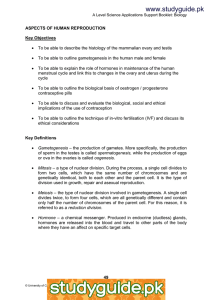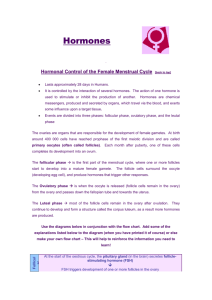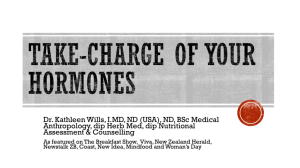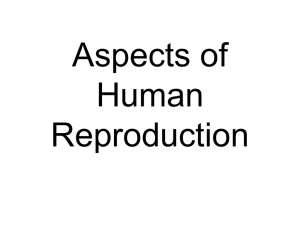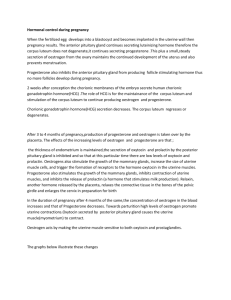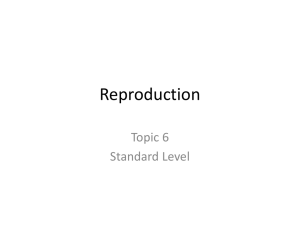• To be able to describe the histology of... • To be able to outline gametogenesis in the... www.XtremePapers.com
advertisement
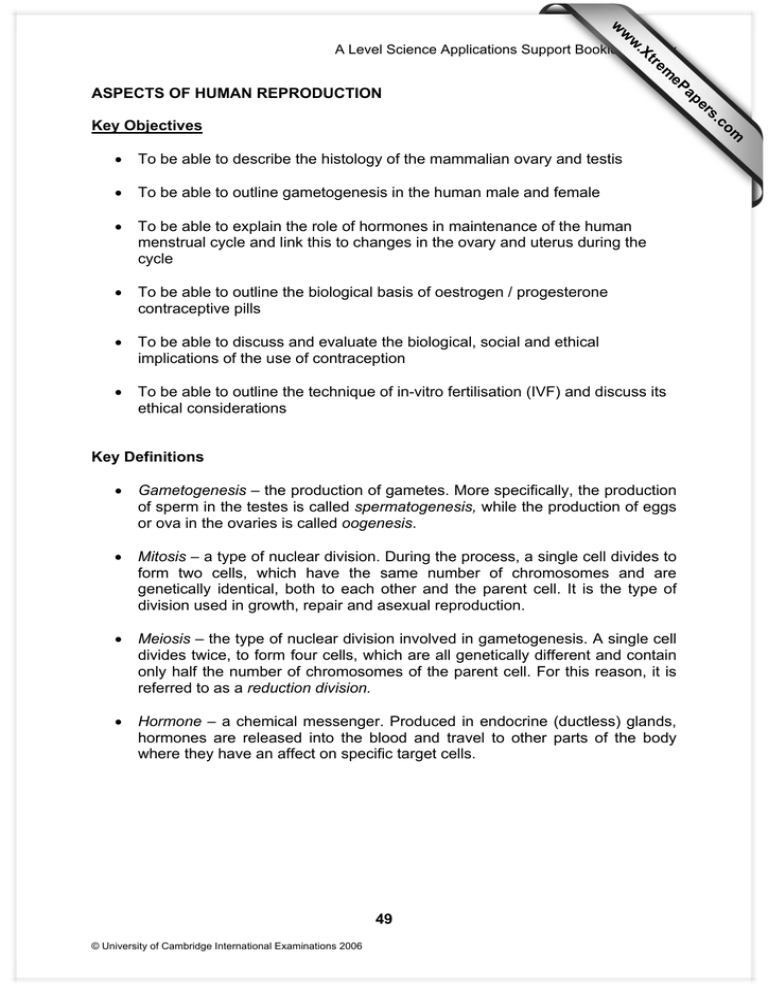
w w w ASPECTS OF HUMAN REPRODUCTION ap eP m e tr .X A Level Science Applications Support Booklet: Biology om .c s er Key Objectives • To be able to describe the histology of the mammalian ovary and testis • To be able to outline gametogenesis in the human male and female • To be able to explain the role of hormones in maintenance of the human menstrual cycle and link this to changes in the ovary and uterus during the cycle • To be able to outline the biological basis of oestrogen / progesterone contraceptive pills • To be able to discuss and evaluate the biological, social and ethical implications of the use of contraception • To be able to outline the technique of in-vitro fertilisation (IVF) and discuss its ethical considerations Key Definitions • Gametogenesis – the production of gametes. More specifically, the production of sperm in the testes is called spermatogenesis, while the production of eggs or ova in the ovaries is called oogenesis. • Mitosis – a type of nuclear division. During the process, a single cell divides to form two cells, which have the same number of chromosomes and are genetically identical, both to each other and the parent cell. It is the type of division used in growth, repair and asexual reproduction. • Meiosis – the type of nuclear division involved in gametogenesis. A single cell divides twice, to form four cells, which are all genetically different and contain only half the number of chromosomes of the parent cell. For this reason, it is referred to as a reduction division. • Hormone – a chemical messenger. Produced in endocrine (ductless) glands, hormones are released into the blood and travel to other parts of the body where they have an affect on specific target cells. 49 © University of Cambridge International Examinations 2006 A Level Science Applications Support Booklet: Biology Key Ideas The histology of the mammalian ovary and testis and Gametogenesis in humans Spermatogenesis – the production of sperm takes place in the testes. The process begins between the ages of 11 and 15 and will continue for life. Between 100 and 200 million sperm will normally be made every day. There are a number of stages in the production of sperm: • Attached to the epithelial layer of the seminiferous tubules are cells called spermatogonia. These cells are diploid and divide by mitosis to form more spermatogonia. • Some spermatogonia move towards the lumen of the seminiferous tubule and increase in size – at this stage, they are called primary spermatocytes. • The primary spermatocytes divide by meiosis. After the first meiotic division, two haploid cells are formed – the secondary spermatocytes. • The secondary spermatocytes undergo a second meiotic division, giving a total of four haploid spermatids. • Each spermatid will mature into a spermatozoon. • The developing sperm are nourished by Sertoli cells. • The whole process takes approximately 64 days. medium-power photomicrograph of mammalian seminiferous tubules (X100) it is important to be able to explain why the tubules, which are all circular in cross-section, appear a variety of different shapes high-power photomicrograph of t.s mammalian seminiferous tubule layer of spermatogonia attached to epithelium and dividing by mitosis primary spermatocytes dividing by meiosis and moving towards lumen haploid spermatids maturing into spermatozoa mature spermatozoa released into lumen 50 © University of Cambridge International Examinations 2006 A Level Science Applications Support Booklet: Biology Oogenesis – the production of eggs (or ova) takes place in the ovaries. However, unlike the production of sperm, the process begins very early in the life of the female – indeed, when she is still only an embryo. The stages involved are: • About five weeks after the formation of a female embryo, some cells in the tiny developing ovaries start to divide by mitosis, forming diploid oogonia. • When the embryo is 24 weeks old, there will be millions of oogonia in the ovaries. • Up until about 6 months after birth, the oogonia will begin the first division of meiosis. The resulting cells are called primary oocytes. However, they do not complete the division and remain at prophase 1 for many years. Not all the primary oocytes survive and, at puberty, there will be around 400,000 in the ovaries. They are each approximately 20 µm in diameter. • When the primary oocyte enters prophase 1, some surrounding cells form a layer around it, forming a promordial follicle. Some of these then develop into primary follicles, with several layers of surrounding cells, called granulosa cells. Others cells from yet more surrounding cells, called the theca and the granulosa cells secrete a protective layer of glycoproteins, called the zona pellucida. The primary follicles will then remain like this until the girl reaches puberty. • At the onset of puberty, hormones will stimulate the primary follicles to develop into secondary follicles. The oocyte enlarges and a fluid-filled cavity develops. • One primary oocyte begins to grow rapidly, forming a Graafian or ovarian follicle, which is between 1 and 1.5 cm in diameter. • The primary oocyte now completes the first meiotic division, producing one large cell and one tiny cell, called the polar body. The large, haploid cell is called the secondary oocyte, which continues straight into the second meiotic division. However, it again stops before the division is complete, remaining at the stage of metaphase II. • The follicle now ruptures and releases the secondary oocyte, surrounded by granulosa cells (ovulation). • The oocyte is drawn into the oviduct (fallopian tube), mainly by peristalsis, although there are cilia present in addition. In the oviduct, if fertilisation takes place, it will complete the second division of meiosis. • The follicle transforms into a corpus luteum. 51 © University of Cambridge International Examinations 2006 A Level Science Applications Support Booklet: Biology medium-power photomicrograph of developing follicle (X100) primary oocyte surrounded by follicle cells and next to fluid-filled cavity, surrounded by ovary tissue medium-power photomicrograph of mature follicle (X100) ovary tissue follicle cells secreting oestrogen haploid secondary oocyte held at metaphase II of meiosis, ready to be released at ovulation fluid-filled cavity low-power photomicrograph of corpus luteum (X50) corpus luteum tissue that secretes progesterone some follicle cells within corpus luteum that continue to secrete oestrogen http://science.tjc.edu/images/reproduction/Index.htm http://www.columbia.edu/cu/biology/courses/w2501/histology.html www.visualsunlimited.com Gametogenesis http://users.rcn.com/jkimball.ma.ultranet/BiologyPages/ www.umanitoba.ca/Biology/lab14 The role of hormones in the human menstrual cycle and changes in the ovary and uterus during the cycle There are a number of hormones involved in the control of the human menstrual cycle. Two are produced by the ovaries: • • Oestrogen (produced by follicle cells) Progesterone (produced by corpus luteum) Two are secreted by the anterior pituitary gland: • • Luteinising Hormone (LH) Follicle Stimulating Hormone (FSH) Oestrogen begins to be secreted at the onset of puberty, when brings about an increase in the size of the reproductive organs and the development of secondary sexual characteristics. The main role of progesterone is to prepare the endometrium (lining of the uterus). The duration of a normal menstrual cycle is 28 days – day 1 is the first day of menstruation. The main hormonal changes during the cycle are as follows: 52 © University of Cambridge International Examinations 2006 A Level Science Applications Support Booklet: Biology • • • • • • • • • • • Secretion of FSH and LH increases slightly during the first few days. This causes a number of primary follicles to develop, though only one in one ovary continues to develop. The granulosa cells of the developing follicle secrete oestrogen, the levels of which start to rise sharply during the first half of the cycle. The increase in the level of oestrogen inhibits any further secretion of FSH and LH – and their levels start to fall. The oestrogen causes the endometrium to thicken – by day 12 it is 3 – 4mm thick. Around day 12 the secretion the secretion of LH suddenly rises very sharply. This causes the granulosa cells to reduce their secretion of oestrogen and start to secrete progesterone. It also causes ovulation, which normally occurs on day 14 (i.e. half way through the cycle). When the egg has been released, the remaining granulosa cells enlarge and fill up with a yellow substance. It is now called a corpus luteum or yellow body, which continues to secrete large amounts of progesterone and smaller amounts of oestrogen. The progesterone brings about the further development of the endometrium, increasing its supply of blood and the amount of glycogen and lipids in its cells. Its thickness reaches 5 – 6 mm and it is prepared for implantation, if the egg has been fertilised. If fertilisation has not occurred, the oestrogen and progesterone inhibit the secretion of FSH and LH from the anterior pituitary gland. As a result, the corpus luteum degenerates. All four hormones now fall to a low level and, once the oestrogen and progesterone have dropped far enough, the anterior pituitary again begins to secrete FSH and LH and the cycle begins again. The fall in oestrogen and progesterone causes the endometrium to break down and menstruation occurs during the next four to seven days of the cycle. FSH stimulating follicle development 1 3 oestrogen causes development of the endometrium 2 1 LH peak stimulating ovulation 3 progesterone produced by corpus luteum and maintaining endometrium 4 2 4 progesterone level drops in the absence of fertilisation, initiating breakdown of endometrium and triggering next cycle 5 follicle ovum released at ovulation corpus luteum endometrial lining of uterus day of ovulation www.merck.com/mmhe/sec22/ch241/ch241e.html 53 © University of Cambridge International Examinations 2006 5 A Level Science Applications Support Booklet: Biology The biological basis of the oestrogen / progesterone contraceptive pill The oestrogen / progesterone contraceptive pill is also known as the ‘combined oral contraceptive pill’ – or, more commonly, as ‘the pill’. As the name suggests, the pill contains oestrogen and progesterone and works by changing the hormone balance of the body, as a result of which ovulation does not take place. Principally, the high levels of oestrogen and progesterone in such combined oral contraceptive pills inhibit the release of FSH and LH from the anterior pituitary gland. This mimics the natural situation during the luteal phase of the menstrual cycle. In addition, it causes the mucus made by the cervix to thicken, forming a ‘mucus plug’ in the cervix – this makes it more difficult for the sperm to get through to the uterus. It also makes the lining of the uterus thinner, making it extremely unlikely that a fertilised egg could implant. As well as being taken orally, the hormones can be administered by injections or by slow release skin patches. It is a very effective method of contraception. The biological, social and ethical implications of the use of contraception Biological implications – methods of contraception which do not involve hormones (e.g. barrier methods etc.) do not really have any biological implications. However, there are many biological implications when using the oestrogen / progesterone pill. Benefits: • • • • Reduces the risk of developing certain ovarian cysts Reduces the risk of developing cancer of the ovary or uterus Menstruation is more regular and it may help to relieve pre-menstrual tension Reduces the risk of pelvic infection – the mucus plug may prevent bacteria getting into the uterus Side effects and possible risks: • • • • • Some women may develop nausea and head aches Tiredness and mood changes Rise in blood pressure Increased risk of thrombosis. In some women this can be very serious – may cause a stroke or a blood clot in the lungs Small increased risk of breast cancer Social implications – in many parts of the world, the use of contraception is referred to as ‘Family Planning’. As this suggests, the availability of contraception means that 54 © University of Cambridge International Examinations 2006 A Level Science Applications Support Booklet: Biology it is easier to choose when to have children. It is also easier to choose not to have children. The result is that it is possible to plan families around careers and other considerations, such as financial circumstances. It has also meant that, in some countries, the population size has not increased to the extent that it would have done in the absence of contraception. Indeed, in some areas, there is concern that there are too few children being born to be able to sustain the population in the future. In those parts of the world where contraception is not freely available, there continue to be problems of overpopulation and the implications that this has for supply of food, water and other resources. Ethical implications – for many people the benefits of using contraception in terms of control of fertility and birth-control, far outweigh any ethical objections. The benefits may be seen in terms of the opportunities for: • a woman to decide when and if she will conceive • countries to control their population growth • those at medical or psychological risk if pregnant, to avoid such pregnancy • reduced chance of unplanned pregnancy in sexually active teenagers Families from many religious groups see birth control as a God-given way of spacing out their pregnancies and maximising the life-chances of their children For others, ethical objections are seen as outweighing any potential benefits and so some Christians (e.g. Catholics) believe that sexual activity within marriage is Godgiven for the purpose of reproduction, and so artificial contraception such as the pill is morally wrong http://www.ivillage.co.uk/health/whealth/birthcontrol/articles/0,,549123_599845-2,00.html http://en.wikipedia.org/wiki/Contraceptive_pill In-vitro fertilisation and its ethical implications In-vitro fertilisation (IVF) is a technique whereby eggs are fertilised outside the woman’s body. The process involves controlling ovulation through the administration of hormones, removing eggs from the ovaries and allowing sperm to fertilise them in a fluid medium. In-vitro is Latin for ‘in glass’ i.e. it is a reference to fertilisation taking place in glass test tubes. In practice, test tubes are not actually used, but the term is now used to describe any laboratory-based procedure. The first ‘test tube baby’ was born in England on July 25th 1978. The process of in-vitro fertilisation involves the following stages: • Ovarian stimulation – treatment would normally start on the third day of menstruation. This involved the administration of hormones which will have a similar action to FSH and will stimulate the development of multiple follicles in the ovaries. Usually, about 10 days of injections will be necessary. 55 © University of Cambridge International Examinations 2006 A Level Science Applications Support Booklet: Biology • Oocyte retrieval – when the development of follicles is judged to be adequate (usually by monitoring oestrogen levels), the hormone human chorioic gonadotrophin (HCG) is given. This has a similar effect to Luteinising Hormone and would be expected to cause ovulation about 42 hours after injection. In practice a needle is used to remove eggs directly from the ovaries prior to ovulation taking place. • Fertilisation – the eggs are stripped of any surrounding cells and are incubated with sperm (in a ratio of approx 75,000 : 1) for about 18 hours. By that time fertilisation should have taken place. Where the sperm count is very low, it is now possible to inject a single sperm directly into the egg. The fertilised egg will now be placed in a special growth medium and left for 48 hours, by which time it should have reached the 6 – 8 cell stage. • Embryo transfer – embryos which are growing successfully are transferred to the patient’s uterus through a thin, plastic catheter. Often, several embryos are transferred to improve the chances of implantation and pregnancy. During the next two weeks the woman will be administered progesterone, which will help to keep the uterus lining thickened and suitable for implantation. The chances of a successful pregnancy using IVF is approx 20 – 30%. There are many factors which can influence the success rate – for example, age of the patient, quality of the eggs and sperm and health of the uterus. The main complication of IVF is the possibility of multiple births – this is largely due to the practice of transferring several embryos to the uterus at the same time. The possibility of birth defects is a controversial subject in IVF treatment – though most studies do not show a significant increase compared with normal fertilisation. When multiple embryos are produced, it is possible to freeze embryos in liquid nitrogen, when they can be preserved for a very long time. The advantage of this is that if the patient failed to conceive frozen embryos can then be used, without the need to go through the full cycle. Also, if pregnancy did occur, they could return later for a second embryo transfer and pregnancy. Ethical implications of IVF – there are a whole range of ethical issues that may result from the process of IVF. These include: • • • • • Bypassing the natural method of conception and making pregnancy into a technological / medical process Expensive so unavailable for many people and may reduce life-chances of children who cost more to create than through natural conception Fertilising more embryos than will be needed and then discarding unwanted embryos Freezing and long-term storage of embryos with unknown potential effects The potential to create embryos for research or to grow tissues and organs for transplant 56 © University of Cambridge International Examinations 2006 A Level Science Applications Support Booklet: Biology • The potential to select and modify embryos In addition to these issues, IVF also allows babies to be created away from the traditional mother-father model. The process requires sperm, eggs and a uterus – potentially, any of these can be provided by a third party, creating additional ethical and legal considerations. It also provides more possibilities for single people and same sex couples to have children. IVF has allowed women to become pregnant after the menopause. Even after menopause, the uterus is able to carry out its function – though the egg would have to come from an egg donor. This would mean that there would be no genetic link between the woman and the child to which she gives birth. People vary in how acceptable they find some of these issues. For many people, IVF is seen as acceptable, for example, to permit selection of embryos that do not contain lethal alleles of key genes, for example the allele that causes Huntington's disease. People have more difficulty with the potential to select embryos for intelligence, gender or absence of minor defects. Some religious groups, (e.g. catholic Christians) are totally opposed to IVF – sometimes seeing infertility as a call from God to adopt children and may see IVF as usurping the role of God in bringing into the world the children that He wants. www.biologymad.com http://en.wikipedia.org/wiki/In_vitro_fertilization http://en.wikipedia.org/wiki/Sexual_reproduction#Reproduction_in_mammals Aspects of Human Reproduction Self Assessment Questions SAQ 1 Describe the following processes in humans: (a) Spermatogenesis (b) Oogenesis SAQ 2 With reference to the human menstrual cycle, describe: (a) the changes in hormone levels during the cycle. (b) the changes in the ovary and uterus during the cycle. SAQ 3 With reference to contraception : (a) explain the biological basis of the oestrogen / progesterone pill (b) discuss the social and ethical considerations. SAQ 4 With reference to in-vitro fertilisation: (a) Describe how the process is carried out. (b) Discuss the ethical considerations. 57 © University of Cambridge International Examinations 2006
